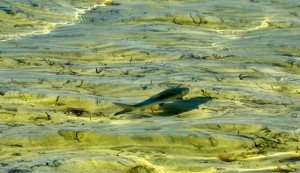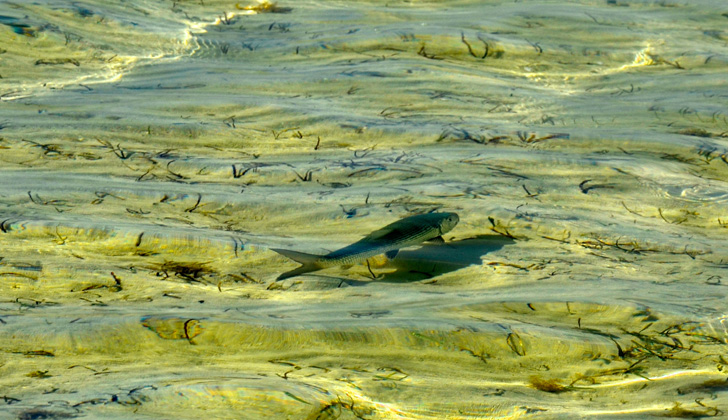THE ANGLING REPORT: BONEFISH DECLINE IN THE FLORIDA KEYS
By Bill Horn
Editor Note:
One of the most important things anglers can do to help bring back Keys bonefish – in addition to those things mentioned above – is to join Bonefish Tarpon Trust. And not at only the Associate ($25) or Member ($100) level. Step up to the plate and become a Conservation ($500) or Gray Ghost Sponsor ($1,000). BTT is an effective and efficient nonprofit. They deserve your support, whether you fish the Keys or not, as much of what they are discovering has application throughout the Caribbean and elsewhere.
Fascinating article by Bill Horn about the decline of the Keys bonefish. Reprinted with permission from the Angling Report, The Newsletter For Anglers Who Travel. Visit Angling Report.com to learn more. You can also pick up Bill Horn’s book in the BTT store
November 2013 -11- Volume 26, Number 11
Don Causey Note: Unless you live in South Florida, you probably haven’t heard that bonefish populations in the Keys are way down. Here’s an in-depth look at the problem and what’s being done to address it. Author Bill Horn is a Keys resident, veteran flats angler (who caught his first bonefish there in 1974), and he has served as assistant secretary of the Interior for Fish, Wildlife, and Parks, chairman of the Great Lakes Fishery Commission, and a member of the National Academy of Sciences environmental board. He is the author of Seasons on the Flats: An Angler’s Year in the Florida Keys – a well received and well reviewed description of flats angling in the Keys.
[dropcap]A[/dropcap] combination of scientific population surveys and anecdotal information from longtime anglers and guides indicates plainly that the Florida Keys bonefish population has been in a slow decline for decades with a marked drop in recent years. The decline in this iconic flats species triggered overdue efforts to understand the fishery and pinpoint the causes adversely impacting it. The Florida Wildlife Commission (FWC), the Bonefish and Tarpon Trust (BTT), and the University of Miami’s Rosenstiel School of Marine Science (UM) are collaborating on these efforts, producing tantalizing tidbits of data beginning to point toward sound restoration management plans.
 Keys bonefish (Albula vulpes) created flats fishing. Starting in the 1920s, anglers ventured to the Keys and discovered the challenging pursuit of the gray ghost in skinny water. Zane Grey, fishing from the legendary Long Key Fishing Club (before it was obliterated by a killer 1935 hurricane), was the first of a long line of bonefish enthusiasts. By the mid-1930s it was discovered that the bonies would take artificial flies. And after a World War II–induced hiatus, outdoor writer Joe Brooks and Keys guide Jimmie Albright demonstrated that one could target and catch big tailing bones on the fly. Through the 1950s, Florida Keys flats fishing meant bonefish. Tarpon were too big to target with the flats tackle of the day and permit were, well, permit.
Keys bonefish (Albula vulpes) created flats fishing. Starting in the 1920s, anglers ventured to the Keys and discovered the challenging pursuit of the gray ghost in skinny water. Zane Grey, fishing from the legendary Long Key Fishing Club (before it was obliterated by a killer 1935 hurricane), was the first of a long line of bonefish enthusiasts. By the mid-1930s it was discovered that the bonies would take artificial flies. And after a World War II–induced hiatus, outdoor writer Joe Brooks and Keys guide Jimmie Albright demonstrated that one could target and catch big tailing bones on the fly. Through the 1950s, Florida Keys flats fishing meant bonefish. Tarpon were too big to target with the flats tackle of the day and permit were, well, permit.
Bone fishing became increasingly popular with the upsurge in saltwater fly fishing and explosive population growth in south Florida. The Keys were transformed from a sleepy community at the end of the road to a big tourist destination. Thousands of acres of flats and mangrove habitats were dredged and filled to create homes, condos, resorts, and marinas for legions of new residents and visitors. Septic systems, installed in porous coral rock, were the order of the day for all this development. In the early 60s, there were only a handful of flats guides from Miami to Key West; today there are over 300. In fact, the flats fishery is estimated to contribute more than $460 million annually to the Keys economy.
Despite growing pressure, bone fishing remained good into the 1980s. Analysis of bonefish tournament catch records from 1968 through 2010 revealed that catch per unit of effort (CPUE), a relatively crude tool for assessing a fishery’s health, was highest in 1988 at nearly 1.5 fish per hour.
In the middle of that decade, however, a whole lot of environmental bills came due with unwelcome consequences. North of the Keys, the U.S. Army Corps of Engineers and the South Florida Water Management District completed re-plumbing the Everglades in the 1960s. The Glades were diked, diverted, and crisscrossed with canals to sluice water from Lake Okeechobee out to sea. Big swaths of dried-up wetlands were converted to sugar cane farming, cattle ranching, or new urban development west of Miami and Ft. Lauderdale. Remaining reduced freshwater was loaded with runoff – mainly fertilizers and excessive nutrients – from sugar cane, tomato farms, and cattle. Everglades National Park (ENP) and Florida Bay, at the south end of the Glades, were getting less than 50 percent of historic water flows, and the water was dirty to boot.
By 1987, Florida Bay, on the Keys’s west and north side, was very sick. Major sea grass die-offs occurred that summer, hyper saline waters became endemic in 1989–1991, and major algae blooms turned clear waters a sickly, gooey green. The pink shrimp fishery was the first to pay the price. In the mid-1960s, Key West shrimpers landed more than 5,000 metric tons of shrimp each year. By the mid-1990s, landings plummeted more than 60 percent, and today only a handful of shrimp boats continues to fish the decimated shrimp. Studies established a clear link between fouled bay waters and the shrimp decline.
Veteran Keys guides and anglers saw a direct connection to bonefish, too. When the C-111 Canal was opened in south Dade County to dry up adjacent lands for farming and to divert water away from Taylor Slough (inside ENP) and Florida Bay, Jimmie Albright predicted trouble for upper Keys bonies, and he was right.
Bone fishing began to slide after the bay got sick. Fish numbers were still pretty good, and the fishery likely got a short-lived bounce from the elimination of “kill” tournaments and
the end of gillnetting for mullet in the bay (bonefish were often caught and killed unintentionally). Good anglers and guides remained successful, but the CPUE numbers for the tournaments exhibited a steady slide until 2010.
Observant anglers and guides were growing concerned and founded BTT in 1998. Mission one was (and remains) to find the answers to why bonefish are in trouble and what can be done to turn things around. Getting hard information was a priority. Fishing was always better in the good old days; the mind remembers the good days and edits out the bad, so fisheries scientists look for facts rather than relying on misty memories. In 2003, BTT teamed up with UM to conduct the first Keys bonefish census. That first year, the sampling and number crunching concluded that 290,000 bones inhabited the Keys and Biscayne Bay. Subsequent efforts – using the same methodology – through 2008 yielded numbers up to 364,000, with a mean population prediction of 316,000 fish. The population appeared stable.
Click here to read complete story […] and join the Bonefish & Tarpon Trust



